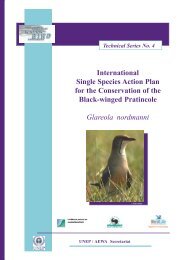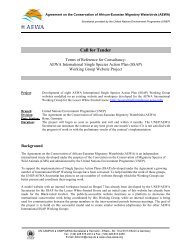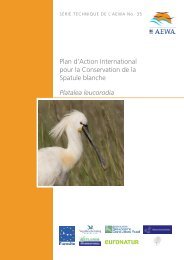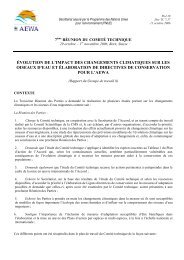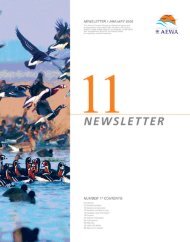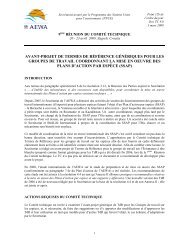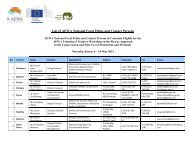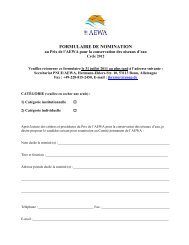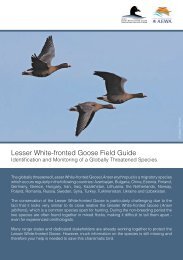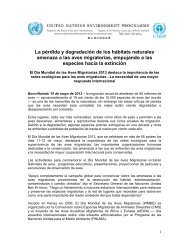International Single Species Action Plan for the ... - AEWA
International Single Species Action Plan for the ... - AEWA
International Single Species Action Plan for the ... - AEWA
You also want an ePaper? Increase the reach of your titles
YUMPU automatically turns print PDFs into web optimized ePapers that Google loves.
<strong>AEWA</strong> Technical Series No. 36<br />
5. Framework <strong>for</strong> <strong>Action</strong><br />
5.1 Lesser White-fronted Goose <strong>Action</strong> <strong>Plan</strong> Goal, Purpose, and Results<br />
This section identifies and defines <strong>the</strong> Goal, <strong>the</strong> Purpose, and Results of <strong>the</strong> <strong>Action</strong> <strong>Plan</strong> and<br />
describes indicators and means of verification <strong>for</strong> monitoring its implementation and<br />
effectiveness.<br />
The Goal is <strong>the</strong> ultimate conservation objective to which this <strong>Action</strong> <strong>Plan</strong> contributes, namely<br />
restoration of Lesser White-fronted Goose to a favourable conservation status. The<br />
Purpose refers to <strong>the</strong> actual role of <strong>the</strong> <strong>Action</strong> <strong>Plan</strong> itself, namely to stop and reverse <strong>the</strong><br />
current population decline. The Results are <strong>the</strong> changes required <strong>for</strong> this Purpose to be<br />
realised.<br />
A priority has been assigned to each Result, according to <strong>the</strong> following scale:<br />
Essential: a Result that is needed to prevent fur<strong>the</strong>r large declines in <strong>the</strong> population that<br />
could lead to <strong>the</strong> species’ extinction.<br />
High: a Result that is needed to prevent a decline of more than 20% of <strong>the</strong> population<br />
within 20 years.<br />
Medium: a Result that is needed to prevent a decline of less than 20% of <strong>the</strong> population<br />
within twenty years.<br />
Low: a Result that is needed to prevent local population declines or which is likely to<br />
have only a small impact on <strong>the</strong> population across <strong>the</strong> range.<br />
However, owing to <strong>the</strong> strongly contrasting sizes of <strong>the</strong> subpopulations, some refinement of<br />
<strong>the</strong>se categories should be applied practice. Hence, an <strong>Action</strong> may be High <strong>for</strong> a given<br />
subpopulation, even if <strong>the</strong> overall impact on <strong>the</strong> global population size would place it in <strong>the</strong><br />
‘Low’ category. In <strong>the</strong> case of <strong>the</strong> Lesser White-fronted goose, unless such considerations are<br />
taken into account, all actions <strong>for</strong> <strong>the</strong> Fennoscandian subpopulation would automatically<br />
become ‘Low’ priority.<br />
Timescales are attached to each Result using <strong>the</strong> following criteria:<br />
Immediate:<br />
Short:<br />
Medium:<br />
Long:<br />
Ongoing:<br />
Completed:<br />
to commence within <strong>the</strong> next year.<br />
to commence within <strong>the</strong> next 3 years.<br />
to commence within <strong>the</strong> next 5 years.<br />
to commence within <strong>the</strong> next 10 years.<br />
an action that is currently being implemented and should continue.<br />
an action that was completed during preparation of <strong>the</strong> action plan.<br />
The Results and Objectively Verifiable Indicators have been selected to address <strong>the</strong><br />
challenges set out in Chapter 3, in particular:<br />
• to eliminate mortality of birds due to biologically unsustainable hunting pressure – in<br />
spite of <strong>the</strong> legal protection af<strong>for</strong>ded to <strong>the</strong> species across most of its range;<br />
• to ensure that all of <strong>the</strong> key sites, including roosting and feeding sites, used by Lesser<br />
White-fronted Geese are adequately protected and managed;<br />
• to minimize disturbance and predation on <strong>the</strong> breeding grounds, <strong>the</strong>reby helping to<br />
maximize productivity;<br />
• to prevent fur<strong>the</strong>r anthropogenically caused introgression of DNA from o<strong>the</strong>r goose<br />
species into <strong>the</strong> wild population of Lesser Whitefronts;<br />
• to fill <strong>the</strong> still-significant knowledge gaps concerning <strong>the</strong> species’ numbers and<br />
movements.<br />
<strong>International</strong> <strong>Single</strong> <strong>Species</strong> <strong>Action</strong> <strong>Plan</strong> <strong>for</strong> <strong>the</strong> Conservation of <strong>the</strong> Lesser White-fronted Goose 47



